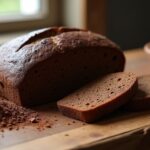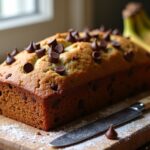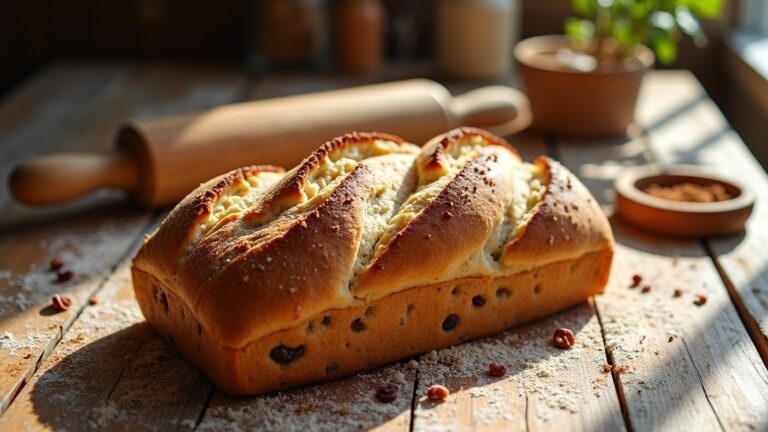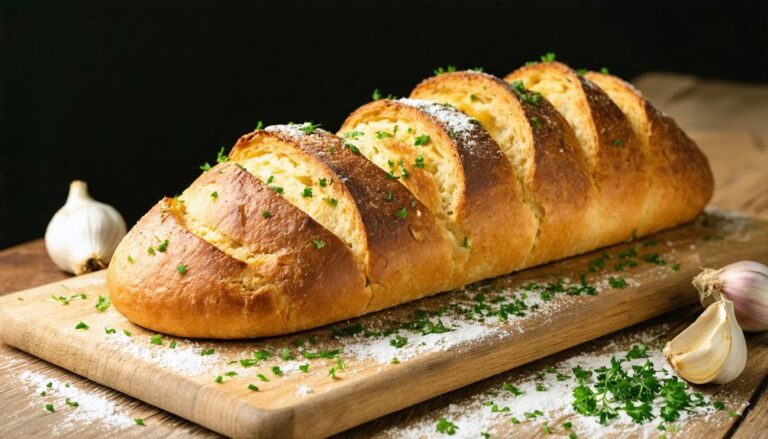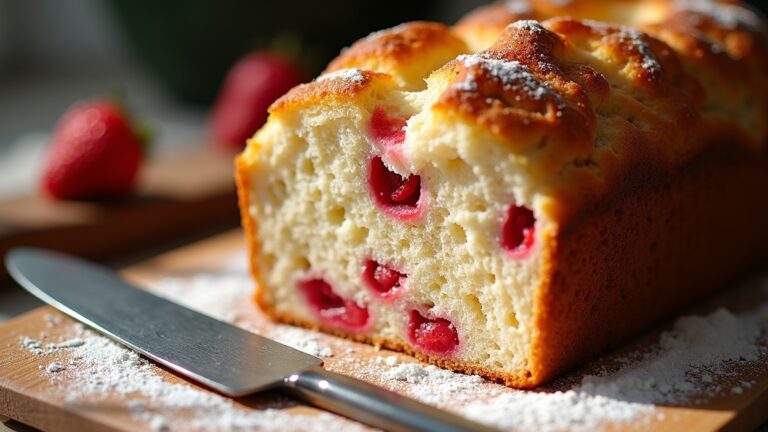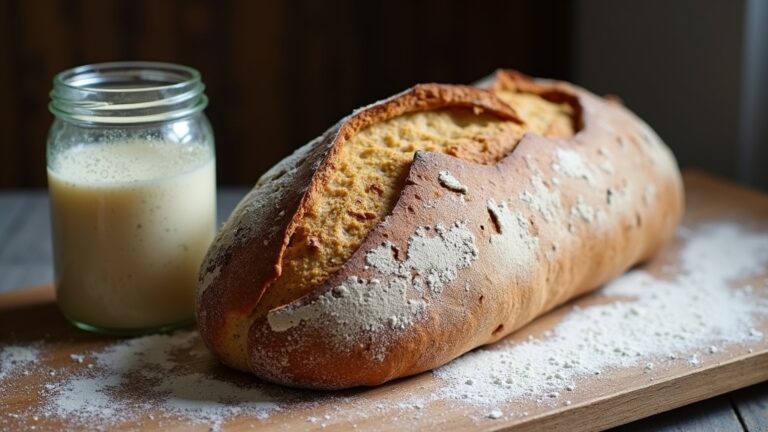Lentil Bread Recipe
I’ve recently crafted a delicious lentil bread recipe that perfectly balances nutrition and flavor. Start with mixing 1 cup of pureed cooked green lentils with 2 cups whole wheat flour, 1 cup all-purpose flour, 1/2 cup rolled oats, and 1/4 cup ground flax seeds. Bake at 375°F for 50 minutes. This loaf packs 10g of protein per serving and is an excellent fiber source, enriching any meal. Intrigued? I’ll show you how this can transform your culinary routine.
Contents
History
While tracing the roots of lentil bread, I discover that its origins stretch back to ancient times when civilizations first began cultivating lentils. These legumes, integral to the diets of early societies, were ground into flour, mingling with other ancient grains to form nutritious, dense breads. The craft of transforming lentils, rich in protein and fiber, into bread highlights its cultural significance, providing sustenance in regions where wheat or barley were less accessible.
Modern adaptations of this ancient staple embrace culinary innovation, blending traditional techniques with contemporary flavors. As a culinary enthusiast, exploring the precise ratios of lentil flour to water, the fermentation process, and the baking temperatures offers a fascinating glimpse into a rich, enduring food tradition.
Recipe
Lentil bread, a nutritious and hearty alternative to traditional wheat-based breads, offers a delightful twist for those looking to diversify their baking repertoire. This recipe harnesses the natural earthiness of lentils paired with a blend of whole grain flours to create a loaf that is not only fulfilling but also packed with protein, fiber, and essential nutrients. Ideal for sandwiches, toast, or simply enjoyed with a smear of butter, lentil bread serves as a robust canvas for both sweet and savory toppings.
Baking lentil bread is straightforward and a great introduction to using legumes in unconventional ways in the kitchen. The recipe involves cooking lentils until tender, blending them, and then mixing with a variety of flours and seeds to achieve a dense yet moist loaf. The inclusion of ingredients like flax seeds and oats not only enhances the texture but also boosts the nutritional profile, making it a wholesome choice for meals throughout the day.
Ingredients:
- 1 cup cooked green lentils, pureed
- 2 cups whole wheat flour
- 1 cup all-purpose flour
- 1/2 cup rolled oats
- 1/4 cup ground flax seeds
- 2 teaspoons baking powder
- 1 teaspoon salt
- 1/2 teaspoon baking soda
- 2 tablespoons honey or maple syrup
- 1 tablespoon olive oil
- 1 1/2 cups water
- 1/4 cup sunflower seeds (optional, for topping)
Cooking Instructions:
Start by preheating your oven to 375°F (190°C) and greasing a standard loaf pan. In a large mixing bowl, combine the whole wheat flour, all-purpose flour, rolled oats, ground flax seeds, baking powder, salt, and baking soda. In another bowl, mix together the pureed lentils, honey, olive oil, and water until well combined. Pour the wet ingredients into the dry ingredients and stir until just mixed; the batter should be thick but pourable. Transfer the batter into the prepared loaf pan, smoothing the top with a spatula. If using, sprinkle the sunflower seeds evenly over the surface. Bake in the preheated oven for about 50 minutes, or until a toothpick inserted into the center of the loaf comes out clean.
Additional Tips:
When making lentil bread, verify that the lentils are thoroughly cooked and smoothly pureed to prevent grainy textures in your bread. You can experiment with different types of lentils, like red or black, for varying flavors and colors. If the batter seems too dry, adjust by adding a bit more water until you reach the desired consistency. For a vegan version, opt for maple syrup instead of honey. Allow the bread to cool completely in the pan before slicing to help it set and prevent it from crumbling. This bread freezes well, so consider making a double batch to save time on future meals.
Cooking Steps
First, preheat your oven to 350°F to guarantee it’s ready for baking. Next, sift together the dry ingredients in one bowl, then separately whisk the wet ingredients until they’re well incorporated. Finally, combine both mixtures, stirring thoroughly to create a smooth batter before pouring it into a greased loaf pan.
Step 1. Preheat Oven to 350°F
Before mixing your ingredients, it’s essential to preheat your oven to 350°F. This specific oven temperature is vital for achieving the perfect crust and texture in your lentil bread. By allowing the oven to reach the desired heat before you slide in your dough, you guarantee that the baking time is used efficiently. A stable temperature promotes even cooking, preventing the outside from over-browning before the inside is fully baked. Remember, consistency in oven temperature is key to the success of this culinary experiment. It’s not just about heating; it’s about setting the stage for transformation, where your blend of innovative ingredients will turn into a delightful, wholesome loaf. So, let’s get that oven ready and set the foundation right for your next baking masterpiece.
Step 2. Mix Dry Ingredients Together
As we’ve warmed the oven, it’s time to focus on the dry ingredients that will form the backbone of our lentil bread. Begin by whisking 1 cup of finely ground lentil flour—a superb source of protein and fiber—with 1 cup of whole wheat flour to add a nutty flavor and increase the bread’s nutritional value. Introduce 1 teaspoon of baking powder and a 1/2 teaspoon of salt to guarantee proper rise and flavor enhancement. For those exploring ingredient substitutions, almond flour can replace whole wheat for a gluten-free version, enhancing the health benefits with a boost of vitamin E. This precise blend sets the stage for a robust, nutrient-packed loaf, inviting innovation into your baking repertoire.
Step 3. Add Wet Ingredients
While the dry ingredients sit ready, we’ll turn our attention to incorporating the wet components essential for our lentil bread. Begin with 1 cup of warm water—this aids gluten development for a softer texture. Next, integrate 1/4 cup olive oil, which imparts moisture and enriches the bread’s flavor profile. Add two beaten eggs to bind the ingredients effectively, enhancing structural integrity. Finally, stir in 1 tablespoon of apple cider vinegar; it’s vital for its wet ingredient benefits, introducing a subtle tanginess that elevates the overall flavor palette.
These additions not only contribute to the bread’s texture and moisture but also play significant roles in flavor enhancements, ensuring each bite is deliciously complex.
Step 4. Combine Ingredients Thoroughly
Now, let’s thoroughly combine the wet and dry ingredients to guarantee our lentil bread has the perfect consistency. Start by meticulously measuring each component. Accurate ingredient ratios are essential here; they confirm that the bread’s texture and flavor are ideal. Gently fold the wet mixture into the dry ingredients using a spatula. This method helps incorporate air and prevents overmixing, which can lead to a denser loaf.
For flavor enhancement, verify each ingredient is evenly distributed throughout the batter. This uniformity allows the subtle notes of the lentils to shine and meld beautifully with other elements like herbs or spices you might choose to include. This careful integration elevates the overall gustatory experience of our innovative lentil bread.
Step 5. Pour Batter Into Pan
I carefully pour the smooth lentil batter into a greased loaf pan, guaranteeing it’s evenly distributed for ideal baking. Achieving the right batter consistency is essential; it should be silky yet hold its shape, a demonstration of meticulous ingredient blending. Before this step, I double-checked the consistency by letting the batter ribbon off the spoon, a classic technique in baking that confirms it’s not too dense or runny.
Next, I smooth the top with a spatula, employing a gentle touch to maintain airiness. This preparation is fundamental as uniformity in the batter’s surface aids in even rising and browning. I’m now set to bake it, using the precise heat settings critical for transforming this innovative mixture into a delightful, crusty loaf.
Nutritional Guide
Lentil bread, packed with essential nutrients, offers a remarkable combination of protein, fiber, and minerals. The high protein content not only supports muscle repair but also enhances satiety, vital for weight management. Lentils, a powerhouse legume, enrich the bread with dietary fiber, promoting digestive health and stabilizing blood sugar levels.
Here’s a concise nutritional breakdown to illustrate the benefits further:
| Nutrient | Amount per serving | Health Benefit |
|---|---|---|
| Protein | 10g | Muscle repair, satiety |
| Dietary Fiber | 8g | Digestive health |
| Iron | 3mg | Oxygen transport |
| Potassium | 200mg | Heart health |
| Zinc | 2mg | Immune function |
This innovative recipe transforms traditional baking, offering a nutritive profile suited for a health-conscious palate.
Final Thoughts
Reflecting on the nutritional benefits outlined above, it’s clear that incorporating lentil bread into your diet offers more than just a tasty alternative to traditional wheat-based loaves. This innovative recipe not only provides a gluten-free option but also introduces an exciting dimension in the domain of sourdough alternatives. Utilizing precise measurements, such as the specific ratio of lentil flour to water, guarantees a consistently high-quality loaf with ideal texture and flavor. Each ingredient is chosen for its contribution to the overall nutritional profile, enhancing both taste and health benefits. As you experiment with this recipe, you’ll discover the versatility of lentils in baking, making it a staple for those seeking culinary innovation and healthier lifestyle choices.
Frequently Asked Questions
Can I Use Canned Lentils Instead of Dry for This Recipe?
You can use canned lentils, but be aware of texture differences. Rinse them thoroughly to reduce mushiness. This substitution might alter the bread’s structure, so measure precisely to maintain the desired culinary result.
Is Lentil Bread Gluten-Free?
Yes, lentil bread can be gluten-free, offering both the benefits of avoiding gluten and enhancing your diet with lentil’s rich nutrition. Make sure other ingredients like flour are also gluten-free for true conformity.
What Alternative Flours Can I Use for Lentil Bread?
If you’re experimenting with baking, try using chickpea flour or almond flour as innovative substitutes. Both offer unique flavors and textures, enhancing your culinary creations with their distinct, nutrient-rich profiles.
Can Lentil Bread Be Made in a Bread Machine?
Yes, you can indeed whip up this innovative loaf in a bread machine, focusing on gluten-free or whole grain settings to guarantee excellent results with precise measurements of your chosen ingredients.
How Long Does Homemade Lentil Bread Stay Fresh?
Homemade bread typically stays fresh for about 2-3 days. To extend its shelf life, store it in a cool, dry place and consider slicing and freezing for longer-term storage. Always seal it tightly.
Conclusion
Wrapping up, crafting this lentil bread is like painting with nature’s own palette—each ingredient bringing its unique hue and texture. By carefully measuring and mixing the precise amounts, you create a culinary masterpiece that’s not only visually appealing but also packed with nutrients. Whether you’re a seasoned baker or a curious novice, this recipe offers a delightful twist on traditional breads, ensuring every bite is as nourishing as it is delicious. Enjoy your homemade lentil bread, a true reflection of wholesome cooking!

